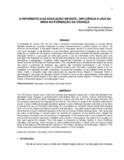| dc.contributor.advisor | Oliveira, Maria Angélica Figueiredo | |
| dc.creator | Medeiros, Sonia Maria de | |
| dc.date.accessioned | 2017-04-25T15:10:32Z | |
| dc.date.available | 2017-04-25T15:10:32Z | |
| dc.date.issued | 2011-09-30 | |
| dc.date.submitted | 2011 | |
| dc.identifier.uri | http://repositorio.ufsm.br/handle/1/2793 | |
| dc.description | Artigo (especialização) - Universidade Federal de Santa Maria, Centro de Tecnologia, Curso de Especialização em Mídias na Educação, EaD, RS, 2011. | por |
| dc.description.abstract | The XXI century society lives in total and constant technological change and in these last decades have
witnessed major changes in socioeconomic and political field, as in culture, science and technology.
Education works with the written language and our culture now lives with a new language, television and
the computer, particularly the language of the internet. This article is a study of the computer watching the
results in early childhood education practices applied in early childhood education and what can be done
to provide the use of information technology as a foundation for computer literacy-based technological
tools not only for children but also for teachers and educators . The paper reports experiments conducted
at the School of Early Childhood Education of the City of Innocent People Restinga Seca - RS, noting that
the entry of technology in schools does not exclude the presence of the teacher who, despite the
technological innovations the human being is irreplaceable. In this context, both in and outside the school
environment the teacher becomes a facilitator and a learner in the process, the search for innovations in
their work against the student. Thus, this paper is structured as follows, Section 2: Early Childhood
Education and learning, which focuses on early childhood education in Brazil and how learning takes
place at this stage of child development, Section 3: The media, concepts and media types , Section 4: The
media and early childhood education, and finally Section 5: Final Thoughts. | eng |
| dc.language | por | por |
| dc.publisher | Universidade Federal de Santa Maria | por |
| dc.rights | Acesso Aberto | por |
| dc.subject | Educação | por |
| dc.subject | Informática | por |
| dc.subject | Educação infantil | por |
| dc.title | A informática na educação infantil: influência e uso da mídia na formação da criança | por |
| dc.type | Trabalho de Conclusão de Curso de Especialização | por |
| dc.degree.local | Polo de Santa Maria, RS, Brasil | por |
| dc.degree.specialization | Mídias na Educação, EaD | por |
| dc.description.resumo | A sociedade do século XXI vive em total e constante transformação tecnológica e nessas últimas
décadas assistiu-se a grande mudanças no campo socioeconômico e político, quanto na cultura , da
ciência e da tecnologia. A educação trabalha com a linguagem escrita e a nossa cultura atual vive por
uma nova linguagem, a da televisão e a da informática, particularmente a linguagem da internet. Esse
artigo faz um estudo da informática na educação infantil observando resultados de práticas aplicadas na
educação infantil e o que pode ser feito para prover o uso da informática como alicerce para uma
educação informatizada com base em ferramentas tecnológicas não só para crianças mas também para
educadores e pedagogos. O trabalho relata experiências realizadas na Escola de Educação Infantil
Gente Inocente do Município de Restinga Sêca – RS, ressaltando que a entrada da tecnologia nas escola
não exclui a presença do professor que, apesar das inovações tecnológicas o ser humano é
insubstituível. Nesse contexto, tanto no ambiente escolar como fora dele o professor passa a ser um
mediador e um aprendiz em todo o processo, na busca de inovações no seu trabalho frente ao aluno.
Deste modo, o presente artigo está estruturado da seguinte forma; Seção 2: Educação Infantil e
aprendizagem, que trata da Educação Infantil no Brasil e como se dá a aprendizagem nesta etapa de
desenvolvimento infantil; Seção 3: As mídias: conceitos e tipos de mídias; Seção 4: A mídia e a educação
infantil; e finalmente Seção 5: Considerações Finais. | por |
| dc.publisher.unidade | Centro de Tecnologia | por |


